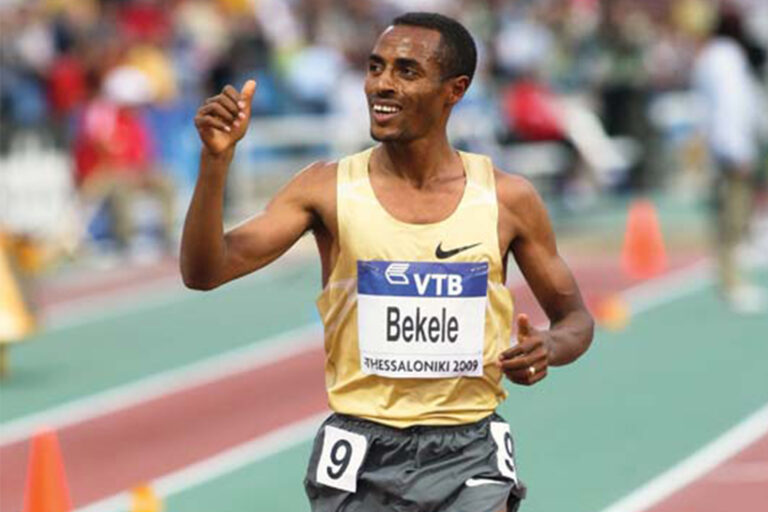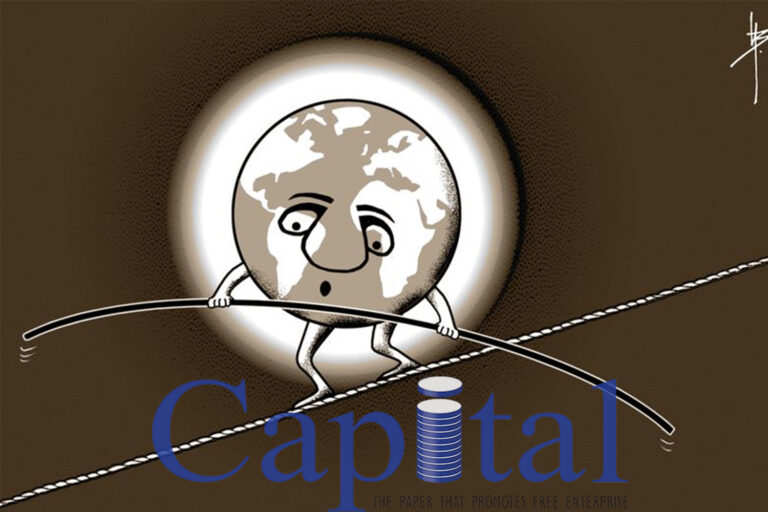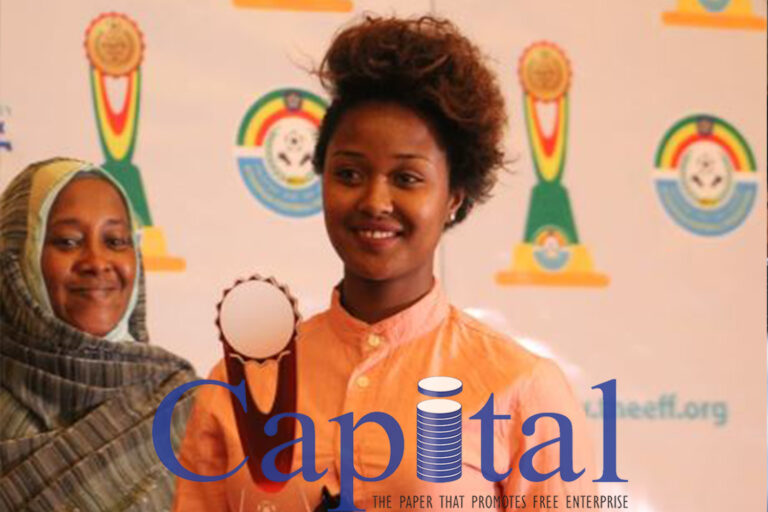The gladiatorial match-up the whole world has been waiting for – Eliud Kipchoge versus Kenenisa Bekele – is on and will take place on 26 April at the 2020 Virgin Money World Athletics Platinum Label London Marathon.
Kipchoge, the 2018 and 2019 World Athlete of the year, is widely considered the greatest marathon runner of all time. The Kenyan is the Olympic champion, a four-time London Marathon winner and the official world record holder for 26.2 miles at 2:01:39. In October, he became the first man to run a sub two-hour marathon at the INEOS 1:59 Challenge, an exhibition event in Vienna.
But his world record was nearly broken by Kenenisa at last September’s BMW Berlin Marathon. The Ethiopian great, who is the current world record holder for both the 5000m and 10,000m and twice World Athlete of the Year, finished just two seconds outside Kipchoge’s world record.
Kipchoge, 35, confirmed in December that he’d be returning to London. kenenisa, 37, has also taken up the challenge to run in what will be one of the most eagerly anticipated races in marathon history.
Kipchoge and Kenenisa have previously met four times over the marathon distance, including twice in London (2016 and 2018), with Kipchoge coming out on top each time. But Kenenisa has the better head-to-head record over all distances and surfaces.
Kenenisa a three-time Olympic gold medalist and he has won 17 world titles on the track, cross-country and indoors. The two men spearhead the men’s field which also includes the second and third-placed finishers from last year, Ethiopia’s Mosinet Geremew and Mule Wasihun.
Kenenisa takes on Kipchoge @ London Marathon
1920s vs. 2020s
We think a full century gives a safe space in time for sober reflection. After a century of topsy-turvy existence/experience the world system is as vulnerable as it was in 1920s. One would expect the global system to have fortified itself with mechanisms to withstand or mitigate the cyclical disruptions associated with its internal dynamics. By now, critical issues such as business cycles, credit cycles, etc. should have had their respective antidotes in place for all eventualities. Instead, the system daftly pushed unsustainable arrangements that are, once again, pushing the whole global economic order towards the precipice. Unlike the 1920s however, the impending disruptions (economic depression, wars, etc.) of the 2020s promise to be potential game changers!
The previous globalization that gave us the roaring 20s (1920s), to use a popular phrase in the west, ended up creating a severe depression, the so-called Great Depression. The price paid to extricate the system from its self-inflicted misery was huge, to say the least. Besides the massive destruction of material wealth, over fifty millions humans were scarified. Whichever way one slices it, WWII was effectively employed to resolving one of the major cyclical downturns (Kondratieff winter) of the world capitalist system. Post WWII saw the emergence of new regulations on capital. The objective was to bring a more balanced arrangement between capital and labor. This political project was later called ‘social democracy’ or in the lingua of economics, the ‘welfare state’. For over thirty years the system functioned as planned, thereby managing to pacify the contention between the two historical antagonists. In the latter part of the 20th century the system was caught up, yet again, with the old issues of over production, diminishing returns, declining profits, etc., To overcome these natural trends of world capitalism, the managers of the system started to employ ad hoc methods to save the established peace. Beginning with the abandonment of the Bretton Woods Agreement (‘gold standard) the status quo decided to heavily indulge in the massive credit creation across the planet. This brought some respite to the system.
When the above ad hoc strategies start to run out of steam, capital took a more aggressive posture against labor. The demise of the ‘socialisms’ gave impetus to capital’s pointed moves, just as the rise of socialism in the early 20th century helped the formation of the welfare states after WWII. In late 20th century, the reigning global plutocracy endorsed neoliberalism (market reigns supreme) as the designated overarching ideology of all nation states. Before long, globally entrenched interests started to promptly dismantle the concessions that were conceded to labor in the ‘golden years’ of the system (1945-1970). The ‘deep state’ was given the overall task of overseeing the global implementation of neoliberalism. To this end, new institutions like WTO, global media, etc., were set up and old ones like the universities were thoroughly reformed to blunt out critical inquiries. Others deemed too dangerous were completely discarded. The result is a stranglehold of transnational capital over all humanity! The rest is history! Today, unlike the 1920s, the ‘specter of socialism’ is not palpably threatening the global order. This reality has encouraged the global parasitic classes to engage in blatant criminal activities with impunity!
Like the 1920s the world system is again facing a serious existential threat. By any measure, this world system proved to be resilient and robust. Its capacity to dynamically construct, deconstruct and reconstruct is legendary (Samir Amin). This time around, however, there are secular trends that might seriously undermine its very ethos! For a start, cheap energy is no more, establishment rhetoric aside, including ‘the paid sciences’, compliment of crony capitalism. Planetary sinks are clogged, without any real possibility of de-clogging (pollution, etc.). Some of the critical renewable resources are being depleted beyond the capacity of the natural ecosystem to replenish them (top soil, fresh water, fish, etc., etc.) Besides the above, dwindling human population (except Africa), relative to global installed capacity, industrial or otherwise, (to say nothing about affordability) has become a major challenge. But without continuous growth, i.e., unsustainable consumption, the global economic system will come to a screeching halt. Strangely enough, it is industrialization/urbanization that has proved to be the most effective means of population control. Paradoxically, successful capitalism (OECD) has not been all that friendly to the natural phenomenon of procreation. Therein lies the rub! Going forward, crony capitalism’s political manifestation might even be worse.
“The major western democracies are moving towards corporatism. Democracy has become a business plan, with a bottom line for every human activity, every dream, every decency, every hope. The main parliamentary parties are now devoted to the same economic policies – socialism for the rich, capitalism for the poor – and the same foreign policy of servility to endless war. This is not democracy. It is to politics what McDonalds is to food.” John Pilger. Good Day!
Israel Manaye
Name: Israel Manaye
Education: Diploma
Company name: Israel Leather Works
Title: Founder
Founded in: 2018
What it does: Leather products
HQ: Addis Ababa
Number of employees: Two
Startup Capital: 20,000 birr
Current Capital: Growing
Reasons for starting the business: To create our own sustainable business
Biggest perk of ownership: Creating opportunity for others
Biggest strength: Seriousness and commitment
Biggest challenging: Credit culture of the society
Plan: To start exporting
First career: Graphics’ designer
Most interested in meeting: Haile G/silase
Most admired person: My father
Stress reducer: Praying
Favorite past time: Watching movies, reading
Favorite book: Konjowochu, by Serk Danel
Favorite destination: Italy
Favorite automobile: Jeep
Losa Abera among top five African women to watch in 2020
LIST
Goal profiles our top five African women footballers to keep tabs on over the next 12 months; which of this quintet could be the year’s breakout star?
#5 Barbara Banda (Zambia/Logrono)
The 19-year-old scored eight goals in 17 outings to rescue her side from top flight relegation last season, and has continued from where she left off to hit six times in 10 matches this term and inspired the Copper Queens to the final stage of the Tokyo 2020 Caf Women’s Olympics qualifiers. It’s the first time Shepolopolo have reached this stage.
#4 Losa Abera (Ethiopia/Birkirkara)
Abera is emerging as one of Africa’s hot prospects and is currently the most decorated Ethiopia female player.
She regularly hit double figures on domestic outings in Ethiopia before leaving Adama City for Maltese side Birkirkara, where she has scored an extraordinary 22 goals in nine appearances in her maiden professional season in Europe.
She scored three goals during the Tokyo 2020 Caf Women’s Olympic Qualifiers despite her side bowing out in the second round against Cameroon.
With the East Africans seeking a return to the African Women’s Cup of Nations for the first time since 2012, Abera is expected to spearhead their quest and also help Birkirkara to European success in next year’s Uefa Women’s Champions League.
#3 Charlene Meyong (Cameroon/Louves Minproff)
Meyong scored Louves Minproff’s only goal in the final as they defeated Amazones FAP to reclaim the Cameroon Women’s League title in March, before the 21-year-old starred at her maiden Women’s World Cup outing, participating in all four matches in France this summer.
#2 Anam Imo (Nigeria/Rosengard)
The youngster finished as the top scorer in the Nigerian Women’s Premier League, bagging nine goals with Nasarawa Amazons in 2018.
The 19-year-old, who scooped the NFF Woman Young Player of the Year 2018, starred as Nigeria won a record ninth African Women’s Cup of Nations in Ghana and then made her Women’s World Cup debut in France, featuring in all four matches for her country this summer.
#1 Temwa Chawinga (Malawi/Kvarnsvedens)
The Flames young sensation is an emerging Malawian that teams on Temwa shot into the limelight after joining Swedish club Kvarnsvedens IK in 2017, scoring 59 goals in 57 matches, including 35 in 28 games last season.
During her maiden continental campaign with Malawi, the 21-year-old scored six goals in four matches and was named joint top scorer to date in the Tokyo 2020 Caf Women’s Olympic qualifiers.






